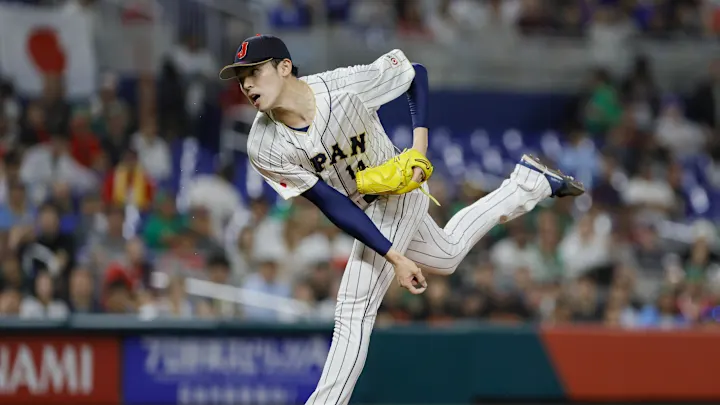Summary
Roki Sasaki signs a league minimum contract with Los Angeles, with a $6.5M signing bonus. The Dodgers bolster their pitching staff, and raise the question, is their offseason dominance bad for baseball?
The wait is over, and Roki Sasaki has chosen to sign with the Los Angeles Dodgers ahead of the upcoming 2025 season, he announced on Instagram. Sasaki was made an offer by 20 different teams, and narrowed down to three finalists, the Dodgers, Padres, and Blue Jays, on January 13th. While the Blue Jays were announced as a finalist, the NL West rival Dodgers and Padres were strongly believed to be the favorites for the right-hander. On the morning of January 17th, a report from Francis Romero revealed that San Diego was no longer in the running, and to no one’s surprise, Sasaki announced his move to LA later that day.
Unlike the previous winter, where Los Angeles spent over $1 billion between Japanese phenoms Yoshinobu Yamamoto and Shohei Ohtani, Roki Sasaki’s signing is capped at league minimum, due to the MLB’s international free agency rules. Sasaki, at 23, is considered a professional amateur and will earn $760,000, in his first year, with a major signing bonus of $6.5 million. The affordability of Sasaki rises his value mightily, effectively turning him into a rare no-risk, high-reward player.
While he rose to prominence within the baseball world during the last two weeks of his posting window, the chase for Sasaki was a multi-year process. The Japanese superstar had been receiving attention from Major League teams all the way back to before his appearances in the 2023 World Baseball Classic. The impact of fellow national team pitchers played a major role in the process as well. It has been noted that Sasaki grew up idolizing now-Padre Yu Darvish, a 39-year-old who has the record for the most strikeouts by a Japanese-born pitcher. Therefore, one of San Diego’s primary selling points was allowing the Japanese baseball icon to play the role of a mentor for Sasaki. On the other hand, as mentioned earlier, the Dodgers signed Sasaki’s WBC teammates, Shohei Ohtani and Yoshinobu Yamamoto the previous year. Sure enough, Los Angeles pitched the idea of a reunion between the three superstars, which undoubtedly is an instrumental part of why Sasaki will be wearing Dodger Blue in 2025.
So, the next question fans have raised is, what is L.A. getting in a player like Sasaki?
“Generational talent”, is the terminology that has been frequently tossed at him by Japanese scouts and analysts. However, unlike his counterparts Ohtani and Yamamoto who are more outspoken, Sasaki is very reserved, enough to draw reports from MLB general managers and others included in the recruiting process regarding his quiet approach to their meetings and workouts. On the field, however, nothing is quiet in Sasaki’s pitch arsenal. He features an electric fastball that averaged out at 100.5 MPH in the WBC semifinals and has topped out at 102.5. On top of that, he has a wipeout splitter that balances his fastball nicely. Finally, he has a slider that he uses occasionally as a throw-in pitch, that still grades out as above-average. Put it all together, and you’ve got yourself a player who can generate swings and misses about as well as anyone in the sport.
So, with Sasaki’s talent in mind, how will the Dodgers’ rotation stack up in 2025? With already having signed 2-time Cy Young winner Blake Snell, the addition of Sasaki gives manager Dave Roberts a welcomed logjam at starting pitcher. There are reports that the Dodgers will use a six-man rotation, to maintain player health, and ease Sasaki into his Major League career. If they went that direction, it would look something like this: 1. Blake Snell, 2. Yoshinobu Yammamoto, 3. Roki Sasaki, 4. Tyler Glasnow, 5. Shohei Ohtani, 6. Landon Knack. The sixth spot is certainly up for debate, but regardless of who wins the role, the first five could make an argument to be the greatest 5-man rotation in MLB history.
The final question is, is it bad for baseball? On top of spending $1.375B on their current roster, the Dodgers were able to persuade Sasaki to sign a contract that expended only $7.2M. Additionally, what allows these Dodgers spending sprees to happen, is the contract deferrals from players, most notably Shohei Ohtani deferring $680M of his $700M contract. This allows the Dodgers to continue to go after what feels like every top player on the market, and at least be competitive for them. While no conclusion can be made on whether it’s good or bad for baseball, there are some clear implications. The creation of a “superteam”, whether the team is liked or not, draws major national viewership. However, the general optimism for fans of the other 29 teams, has tanked significantly, and it can seem as if supporting your team isn’t worth it.
To wrap up, fans of individual teams are negatively affected and upset about the Dodgers roster creation, but fans of no specific team, are much more likely to buy a subscription to MLB.tv, or tune into ESPN on Sundays to watch the “superteam”.

